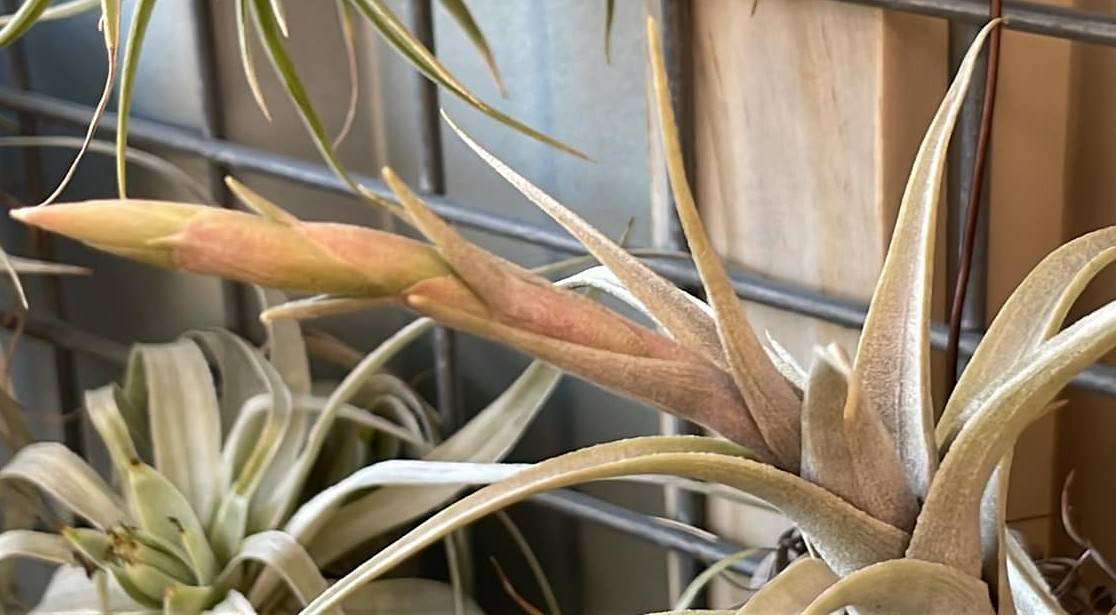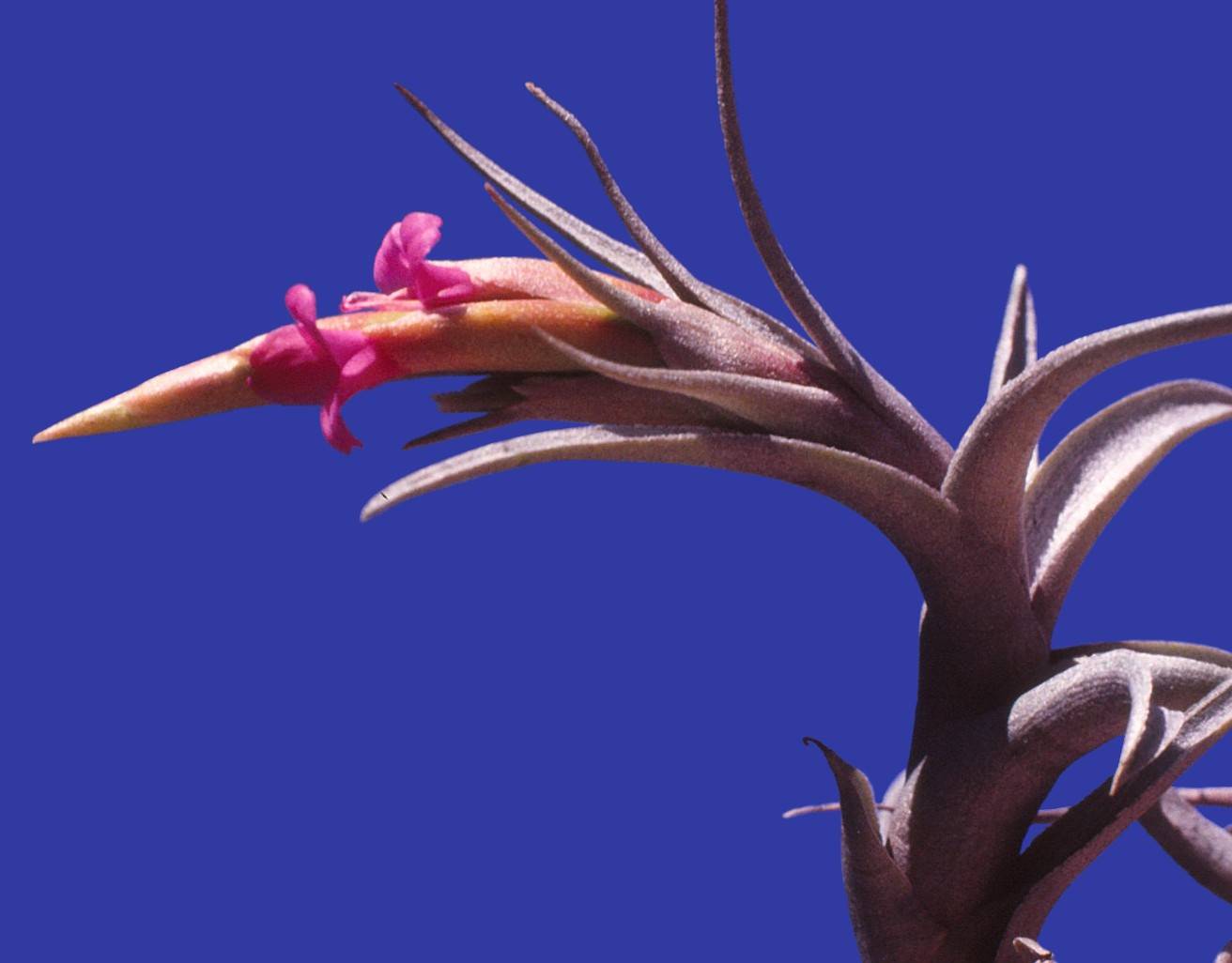


A Tillandsia churinensis Rauh, characteribus sequentibus differt: habitu minori, foliis angustioribus, spicis angustioribus, subteretibus nec valde complanatis, floribus laxe dispositis rhachim flexuosam per anthesin exhibentibus, bracteis florigeris minoribus quam sepala brevioribus, ecarinatis acutisque, sepalis adaxialibus tertium partem connatis nec liberis, petalis longioribus; a T. macbrideana L.B. Sm. foliis multo longioribus usque ad 10 cm metientibus, laminis foliorum quam vaginas multo longioribus, acuminatis, scapo longiori, inflorescentia non semper simplice, spicis solum 6 mm latis, floribus laxe dispositis, rhachidi flexuosa et visibili, bracteis florigeris quam sepala brevioribus, petalis longioribus.
Plant long caulescent, roots present, stem 15-25 cm long, sometimes branched, pendent to ascending, leaves many, to 10 cm long, polystichous, laxly imbricate, slightly secund, rigid, on both sides, densely appressed, cinereous-lepidote.
Leaf sheaths to 3 cm long, 1.6 cm wide, elliptic merging with the blade;
blades 1 cm wide above the sheath, triangular acuminate, recurved near apex, 5cm long.
Scape slightly decurved, 3-5 cm long.
Scape bracts laxly polystichous, subfoliaceous, the apical ones 2 cm long.
Inflorescence terminal, upright to decurved, a simple spike or bipinnately compound with up to 6 spikes.
Spikes 2-5 cm long, 5-8 mm wide, narrowly elliptic to lanceolate, 3-9 subdistichous flowers, complanate to subterete, rachis flexuous, flat, glabrous, green.
Floral bracts straight, laxly imbricate, the rachis mostly visible, twice as long as the internodes, 12-20 mm long, 611 mm wide, elliptic acute, slightly shorter than the sepals, adaxial glabrous, abaxial green, rose at top, punctulate lepidote, membranaceous edge.
Sepals 13-17 mm long, 3-4 mm wide, lanceolate, acute, the posterior ones carinate and connate for 1/3-1/4 of length.
Petals 2.2-2.9 cm long, 3-4 mm wide, ligulate, tubular, the tips recurved, from ruby red to rose, becoming white toward the base.
Stamens deeply included, filaments straight, 1-1.5 cm long, 0.7-1 mm wide at base, flat, becoming narrower toward apex, 1 or 2 times plicate, anthers 3.5-4 mm long 0.3 mm wide, linear, basifixed, yellow, pollen egg-yellow,
style 9 mm long, thin, white becoming rose near apex,
stigma very small, only as wide as the style, white.
Ovary 3.5 mm high, 2 mm wide, triangular in cross-session, light green.
Distribution: Bolivia, north of La Paz, Rio Sorata, east of Lago Titicaca.
Tillandsia rubia seems to be related to Tillandsia churinensis Rauh and T. macbrideana L.B. Sm.
Tillandsia rubia differs from T. churinensis Rauh by the following characters: plant smaller (blades to 5 cm long vs. to 10 cm), leaves narrower (10 mm wide vs. 15 mm), spikes narrower (5-8 mm wide vs. 8-10 mm), not strongly complanate but to subterete, flowers lax, the flexuous rhachis visible at anthesis, floral bracts smaller and shorter than the sepals, ecarinate and acute, the posterior sepals 1/3 connate, petals longer (to 29 mm long vs. to 25 mm).
Tillandsia rubia differs from T. macbrideana L. B. Smith by having longer leaves (8-10 cm long vs. 3-4 cm), the blades much longer than the sheath (vs. equaling the sheath) and acuminate (vs. acute), the scape 3-5 cm long (vs. very short or lacking), inflorescence not always simple, narrower spikes (5-8 mm wide vs. 15 mm), lax flowers with visible rachis, the floral bracts shorter than the sepals, and longer petals (to 29 mm long vs. to 25 mm).
Notes
There is a collection of tillandsias that has created much discussion between the authors and others for a number of years. The history dates back to the years when Mr. Karel Knize was exporting plants from his nursery just outside Lima, Peru. This predominantly involved cactus and succulent seed and plants collected by Knize during his frequent expeditions throughout Peru and Bolivia. In fact, among the many new species and varieties of cactus he discovered, some were named in his honor (e.g., Cintia knizei, Weingartia knizea).
Of significance to us, he also collected many bromeliads, most of which were tillandsias. His 1994 price-list showed 218 different numbered tillandsias which have become known as KK#1 to KK#218 to collectors. Large shipments were exported to nurseries in the USA, Germany, and elsewhere, from where individual plants have found their way all over the world.
Unfortunately, many of the given names corresponding to certain KK numbers are incorrect, or else only a location or feature was mentioned. In addition, there is no guarantee that two plants from different sources with the same KK number are the same or even related. Another complication is that Knize changed his numbering system over the years. In 1978, his cactus collections had KK numbers but tillandsias did not. In 1981, he changed his numbering system so that everything above number 3000 was a tillandsia. In 1988 he changed it again so that numbers over 2500 were tillandsias, and hence the current KK 87 (see below) should be equivalent to 2587. Derek Butcher bought 2587 as "mcbridae" in 1988 but it turned out to be a caulescent form of Tillandsia nana. In 1991, the KK numbers specifically for tillandsias started. In that year, seed from KK121 and KK122 was purchased by Butcher, and germinated.
These have not yet flowered (2004) but both seem to be Tillandsia latifolia. Despite all of these drawbacks, there is no doubt that Knize's contributions to the genus tillandsia have been significant when one considers the number of new species and varieties discovered, and the vast area explored.
Len Colgan had the pleasure to visit the Knize nursery in 1993, and brought back a number of tillandsias to Australia. These included a group of plants of similar appearance. The numbers, with the corresponding annotation on the price list, were:
KK#87: "mcbridae (small 3-6cm, rare)"
KK#121:"spec. S. Marcos (Fl. Red) Neuheit"
KK#122:"spec. S. Marcos-Maranon (lv. 2-3cm)"
KK#180:"spec. (near or T. edithae, 2200m)"
KK#185:"nana (Form, root formed, Pl short)"
Over the years, various opinions have been put forward as to the true identity of these KK numbers. It is likely that KK numbers 87, 121, 122, 185 come from Peru (121, 122 are almost certainly the same). They have decurved inflorescences with pink flowers. There are similarities but also differences when compared with, for example, Tillandsia macbrideana, T. churinensis, T. pseudomicans, and T. nana. Whether there is a continuous swarm of plants across Peru, perhaps including those four species and these four Knize numbers, is a matter of conjecture. In fact, related plants have since been collected elsewhere in Peru that complicate the picture further as they do not precisely match species known to us.
When Colgan visited Renate Ehlers in Stuttgart in July, 2002, a serious attempt was made to unravel this group. We determined that KK#180, which comes from northwest Bolivia, is sufficiently different from all other plants mentioned above to warrant being described as a new species. It flowered in the Ehlers collection (imported to Germany by Dotterer) in 1992, and in the Colgan collection in 1994. It is remarkable for the richness in the color of the flowers in an upright inflorescence. Colgan's notes state that the petals have a color which is "somewhere between ruby red and rich wine red with a hint of violet". However, the color can vary to rose. FIGURE 1 is a slightly depauperate and lax inflorescence from 1994 (Colgan), whereas FIGURES 2 and 3 are from its descendents in 2003. The collection location details in the description come from a personal correspondence between Ehlers and Knize.
The precise status of the other four KK numbers, and their relationship to described species, is open for further investigation.